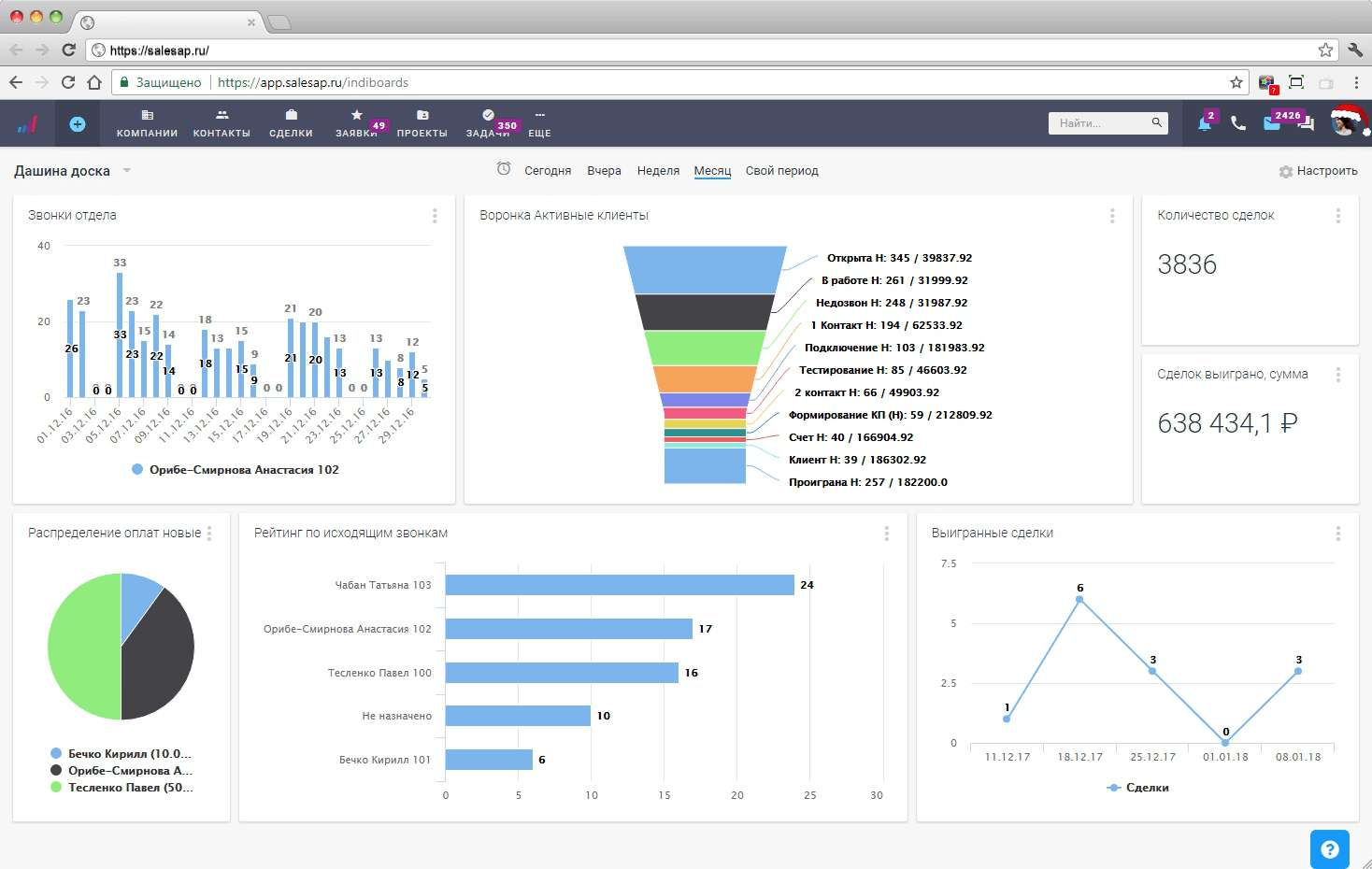At some point in the course of work of any company, the question arises of how to evaluate the productivity of the sales department. After all, it is often the sales department that determines how much profit a business will make. In the past, companies tried to do it by counting the amount of work done by sales departments or the amount of time spent at work, but such evaluation systems are already outdated.
Today those employees who work in the specialized departments should be evaluated according to KPI for sales. Experts have made a list of indicators that have the maximum effect on sales efficiency.
KPI: What Is It?
KPIs, or Key Performance Indicators, are indexes that assess the performance of an organization. Sales indicators help to evaluate the quality of work of each employee of the department or the company as a whole. KPI is the only objective measurement of the cost of working time and performance of branches, departments, divisions or working groups.
If the executives of a company have an understanding of what changes should be made to the purchase funnel to increase the efficiency of the company’s work and improve the personnel motivation system, they realize that KPIs for sales managers should be as simple and clear as possible for all employees.
There are several types of KPIs:
- indicators assessing the results;
- indicators assessing the number of resources spent on production;
- indicators monitoring compliance with the defined processes;
- indicators measuring the ratio of the resources spent and the achieved results.
The calculation of KPIs should be based on the benefits of their application. These indicators should have a genuinely positive impact on sales volumes and should be linked to the performance of particular employees.
Sales Metrics or Sales KPIs: What Is the Difference?
To better understand the difference between sales figures and KPIs, one should understand what does KPI mean in sales. KPI is a factor that ensures high sales figures. There is a direct interrelation between them: the more effective the sales department, the higher the number of products sold.
But it is important to remember that the volume of sales is influenced by other factors as well, such as seasons, discounts and promotions, advertising campaigns and so on. Therefore, the volume of sales is not the only factor that KPIs rely on.
Why Do We Need KPIs?
Performance indicators first of all influence the motivation of employees. In business, the practice of providing bonuses or incentives for employees who perform their work in the most efficient and timely manner is quite common. Exceeding the plan may also be a reason for additional motivation.
If a company has not implemented KPIs, it may encounter certain difficulties in its working process, such as:
- lack of tools and facilities for sales KPI measurement;
- the completion of individual tasks will be taken into account rather than the work performance as a whole;
- the inability to form a project implementation strategy for the company;
- a company may not be able to meet its objectives as a result.
As a result of the introduction of KPI, the company can achieve the following results:
- increasing the overall efficiency of the business;
- drawing up a list of factors and indicators that the company’s work as a whole will depend on;
- planning the future of the company according to its goals;
- list of work normative;
- maximal transparency in the assessment of employees’ performance.
The Most Important Sales KPIs
There are a number of indicators for the evaluation of the efficiency of the sales department. A company selects KPIs for the sales team based on the specifics of their work, demands and additional parameters.

Qualified leads per unit of time
This indicator represents a special index. It is the ratio between the total number of potential clients and the number of clients who have been showing activity during a certain period.
Мarket expansion indicators
Using this indicator, an expert can determine the options for market expansion for a specific company. This allows for both short-term and long-term strategies.
Client acquisition rates
This indicator calculates the amount of money brought to the company by each client. If it turns out that this figure differs significantly between employees, it makes sense to identify the reasons for the divergence and optimize the work process and decide how to set KPIs for sales.
Average annual sales volume
One of the most important sales KPI shows how many sales were made by one manager during a certain accounting period. For large companies, this period can be as long as a year. The calculation of the indicator is based on the number of checks.
Competitor pricing on the market
If the company’s prices are lower than competitors’ and no artificial dumping is taking place, this may indicate that the company’s workflow is well optimized. If it turns out that the prices have to be artificially lowered, or that the cost of goods and services is higher than those of competitors, the optimization of the company’s operations should be reconsidered.
Quality customer service
Working with clients is one of the best sales KPI examples. After all, it is often the way of communication with clients that directly affects the number of sales. In order to determine the efficiency of customer service, as a rule, the following indicators are used:
- the number of clients ready to make a purchase;
- level of conversion of “warm” clients into “hot” ones;
- the number of repeat deals.
Employee satisfaction
One of the best sales KPIs is the level of employee satisfaction. It has been known for a long time that motivated staff will work much harder and close more deals than those who are not interested in making sales. A good option for motivating employees is bonuses and gifts. But if a person likes their working conditions and salary, they will value their position and strive to do their job in the best way possible.
Upsell and cross-sell rates
Cross sales are used to increase conversion. Up-sell is offering clients more expensive goods or more expensive options. Cross-sell is offering clients some extra products in addition to their main purchase. For example, offering a case along with a mobile phone.
NPS
The index of the net promoter score is necessary for analyzing how potential and current clients feel about the company and how their attitude changes depending on the actions taken. This helps to eliminate the flaws in the work of the company.
System indicators
KPI system indicators include site traffic, total sales volume, and other calculation figures. They allow managers to compare the numbers and evaluate the change in the efficiency of client service.
Length of the sales cycle
The sales cycle is the period of time it takes for a potential customer to become a current one. The sales cycle includes market research, initial contact with a potential customer, defining demands, providing supply, overcoming objections and closing a deal. The shorter the sales cycle in the company, the more deals will be closed.

The relative share of the market
An important aspect of KPIs for sales representatives and large companies is the market share of their products. The more goods are available and purchased on the market, the wider will the outreach be and the more profit the team will make.
Pipeline value
This indicator is a graphical tool that can be used to predict the future sales volume by considering the factors influencing clients’ decision on the purchase. If there are too many curves on the chart, the sales are likely to be hindered.
Customer profitability
This indicator represents the potential profit from the acquisition of main products and accompanying goods and services. Therefore, it is necessary to decide what additional goods can be offered to clients. Such a policy will significantly increase the company’s profits. With the help of this indicator, it is also possible to estimate the income the company receives from customer service or a group of customers for a specific period of time. This can be easily measured by comparing the profit from a client and the amount of money spent on closing a deal.
Marketing leads to quality
Evaluation of the quality of the advertising campaign implementation is essential for understanding how effective certain activities increase sales. This indicator should be calculated taking into account the time that has passed since the start of the advertising campaign. This is how the long-term perspective can be assessed.
Transaction stages
The stages of a deal can illustrate the rate of its closing. Naturally, the less time it takes to complete each stage, the faster the deal will be closed and the more sales the company will have. Thus, specialists can forecast the company’s profit more accurately in the future.
Conversions of sales stage
The conversion of sales is the difference between the number of people who visited the site or called the contact center and those who actually bought the product. There are also additional system indicators to determine the degree of efficiency of an enterprise.
A channel of repeat sales
Working with sales channels helps to determine which of them will be most efficient in the case of a specific product. When a sale is carried out directly to clients it is called a direct channel, and if a dealer is involved in sales, it is called an indirect channel. This indicator is among the top sales KPIs, allowing us to define the best option for the company.
Revenue
The profitability index of each individual client or average check indicates the amount of money a client spends on goods and services on average. Focusing on this indicator stimulates employees to sell more products.
Monthly sales growth
This comparative indicator helps to determine if sales have increased during the month. The number of deals and the profit from them can be compared to measure sales growth.
Average profit margin
The average profit for an employee is calculated for a specific period: a month, a quarter, half a year, or a whole year. To do this, the income from all of their deals is summed up and then divided by the number of cases closed.
Most Important Sales KPIs in Sales
The team of the sales department includes the head of the department, sales managers and sales representatives. For a company to be successful, it is important to understand how to set KPIs for sales at all levels.
To understand what are KPIs in sales of a department manager, it is necessary to combine personal and corporate performance indicators. The corporate indicators are related to the performance of the department. They stimulate teamwork and ensure that the manager is committed to the result. Personal indicators, on the other hand, relate to the performance of an individual employee. However, in the case of a manager, the results may not be directly related to sales. Here, the amount of work done with subordinates, planning, reporting, and auditing are important.
As for the sales managers’ KPI, this figure includes:
- the number of meetings, calls, presentations, and other activities intended to close deals;
- the ratio between the amount of action taken and the number of closed deals for each individual manager;
- the average number of actions a manager takes to close a lead;
- how quickly managers contact potential clients;
- the ratio between the number of closed and blown deals for each manager;
- the profit that the manager brings to the company.
The best KPIs for sales representatives are:
- Sales volume is the main indicator of KPI evaluation. It can be the number of units of goods sold during a certain period, the ratio between the actual and target sales volumes, the ratio between the average sales volumes and the number of sales of a given sales representative.
- Sales activity helps to track the speed of work of a sales representative and adjust the strategy according to the schedule.
- Orders-to-returns ratio shows the number of returns each sales representative has and how this number correlates with the average in the company.
How to Choose the Most Important KPI Indicators for Your Industry
To ascertain how to set KPIs for sales, it is important to choose which indicators can be the most efficient in your particular case.
When it comes to sales, the most common indicators are:
- time spent on a single deal;
- time spent working with a lead;
- advertising materials usage efficiency;
- forecast of sales success;
- the size of an average single-deal check;
- duration of the sales cycle;
- the cost of sales to revenue ratio;
- presence of a hole in the purchase funnel;
- managers’ performance indicators;
- sales volumes in respect to location, channel, and territory;
- level of employee satisfaction.
Measuring KPI Key Indicators
There are special formulas for calculating KPI indicators for each specific figure. Today, this process is automated. Excel, which is often used to work with formulas, has special worksheets integrated for that purpose.
There are also programs for calculating the KPI that demonstrate the main indicators, which allows assessing:
- exact working hours of each employee;
- the productivity of each team member;
- the results and indicators of specific employees.
A good help in this process is a CRM program that automatically collects the data on each employee’s productivity while also offering additional tools for facilitating the sales process.
Conclusion
A KPI is an indicator that helps to determine the performance of each individual employee and the department as a whole. There are more than 25 indicators that illustrate changes in sales and related industries. Companies use special programs that not only help to use formulas but also clearly highlight the differences in performance over time or compare scores of different employees. The use of KPI allows to evaluate the personnel work efficiency and boost the company’s sales volumes.
Try Nimble CRM to monitor the work of your company and speed up the processes.


